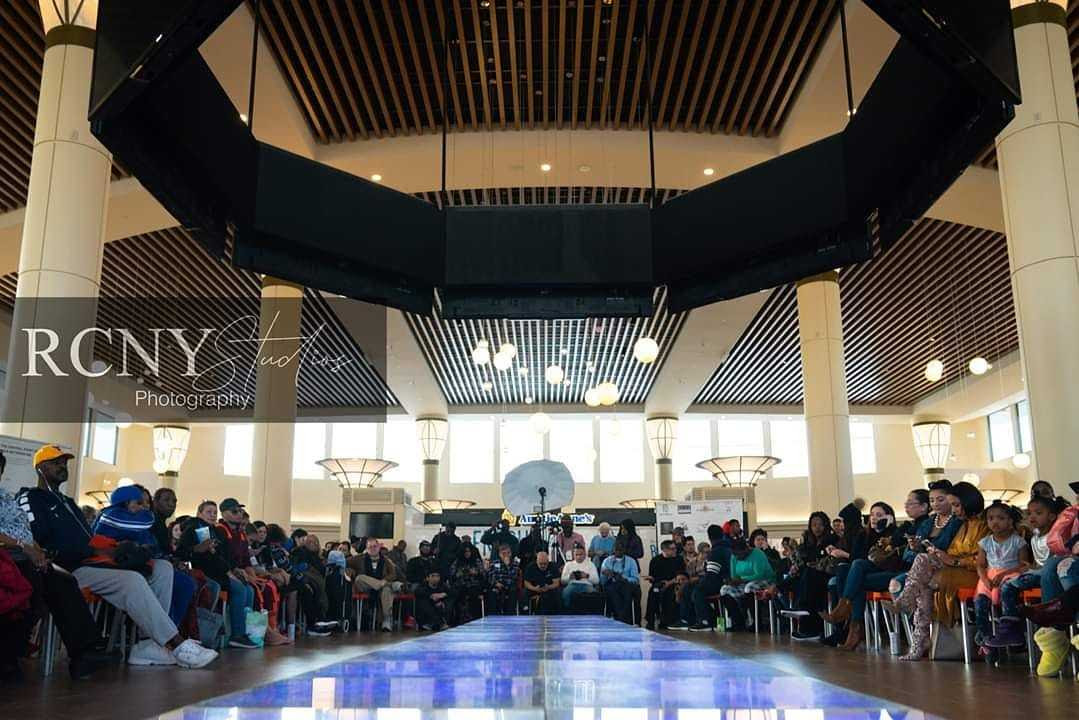Adams Administration Delivers 224 Affordable Homes, Street Safety Upgrades, New Pedestrian Space, Climate Resiliency and Flood Protection Measures
$234 Million Investment Delivers on Promise to Revitalize Downtown Far Rockaway and Provide Critical Improved Infrastructure for Local Residents — Completed Ahead of Schedule and Under Budget
New York City Mayor Eric Adams today marked the completion of two major projects transforming downtown Far Rockaway with 224 affordable homes and major infrastructure upgrades enhancing street safety, climate resiliency, and quality of life completed ahead of schedule. Together, the two projects brought $234 million in investment to downtown Far Rockaway — delivering on key commitments from the “Downtown Far Rockaway Roadmap for Action,” a comprehensive plan released in 2016 to revitalize the neighborhood and improve quality of life for local residents.
“These projects exemplify what it means for New York to become a ‘City of Yes,’” said Mayor Adams. “This is the kind of community-led and community-supported investment we want to see more of and a prime example of government working the right way for the people of this city — getting this done ahead of schedule and under budget. Today is a great day for the Rockaways and another great day of ‘Getting Stuff Done’ for New Yorkers.”
“I am so proud to stand with Mayor Adams and the multiple city agencies who worked collaboratively and efficiently to complete this transformative project that will reinvigorate the Far Rockaway community,” said First Deputy Mayor Lorraine Grillo.
“Our city’s economic comeback is driven by our mayor’s strategic investments in neighborhoods that have historically been left behind,” said Deputy Mayor for Economic and Workforce Development Maria Torres-Springer. “The city is delivering on promises made to Far Rockaway today with transformative affordable housing, green infrastructure, and streetscape projects that make the area safer and more attractive to residents and businesses. My thanks to the city agencies, elected officials, and community stakeholders involved in making the community’s vision a reality.”
Led by the New York City Economic Development Corporation (NYCEDC), the New York City Department of Housing Preservation and Development (HPD), and the New York City Housing Development Corporation (HDC), the $120 million project — called Beach 21st — transformed vacant city-owned land into a new, 100-percent affordable, mixed-use development project with 224 affordable homes near the Far Rockaway-Mott Avenue subway station. Supporting access to vital transit, daycare, and jobs, the building offers apartments affordable to New Yorkers earning between 40 and 80 percent of area median income, with 23 homes with on-site services reserved for New Yorkers who formerly experienced homelessness. The building includes on-site laundry, a fitness room, and a rooftop terrace with a walking track, as well as approximately 28,000 square feet of retail and community space, including a day care center.
Carried out by the New York City Department of Design and Construction (DDC), in partnership with the New York City Department of Environmental Protection (DEP) and the New York City Department of Transportation (DOT), the $114 million infrastructure project was originally estimated to cost $139 million and require seven years, then promised to the community in three years, and now has been delivered three months ahead of the promised three-year schedule and $25 million under budget. The project includes critical street safety improvements, including the addition of more sidewalks, new landscaping, and green infrastructure. It also includes upgrades to 25 blocks of stormwater draining to help reduce the flooding risk from heavy rain. A new, 15,000-foot pedestrian plaza will offer community space maintained by DOT, the Rockaway East Merchants Association, and the Horticultural Society of New York for events, seating, greenery, bike racks, and a public restroom.
In total, the work included:
- More than two miles of new storm sewers and 88 new catch basins to alleviate flooding,
- More than two miles of new curbs,
- 101,000 square feet of new sidewalks,
- 10,000 feet of existing sanitary sewers replaced with new pipes,
- 10,000 feet of aging water mains replaced with new pipes, and
- A net gain of 71 new trees for the neighborhood.
The infrastructure project received the Award for Excellence in Design from the New York City Public Design Commission in 2017. DDC is also building the new Far Rockaway Library for Queens Public Library in the same community, which is anticipated to open next year.
These critical improvements were informed and supported by the Downtown Far Rockaway Working Group, a team of community members, businesses, and nonprofits, along with local and state elected officials. They created the Downtown Far Rockaway Roadmap for Action in 2016, which spurred a rezoning that prioritized affordable housing and support for area businesses.
“Resilient and sustainable housing is key to moving New York City forward,” said Chief Housing Officer Jessica Katz. “As we continue to tackle dual crises in climate change and a housing shortage, projects like this — which came from the Downtown Far Rockaway Roadmap for Action — will help us design a stronger city where all New Yorkers have access to safe, secure, and affordable homes.”
“These projects represent a significant investment in the future of downtown Far Rockaway, and the new storm sewers and rain gardens will help to alleviate street flooding and protect nearby wetlands,” said Chief Climate Officer and DEP Commissioner Rohit T. Aggarwala. “Thank you to our partners at DDC, DOT, and EDC, and a special thank you to Borough President Donovan Richards for his advocacy and funding contribution as we work to improve the quality of life for residents and area businesses. Together, we are making downtown Far Rockaway a more resilient neighborhood.”
“NYCEDC worked with the community, our city partners, and The Community Builders to transform vacant city-owned land at Beach 21st Street into a new mixed-use development that supports affordable housing and access to vital transit, day care, and jobs,” said NYCEDC President and CEO Andrew Kimball. “The project further delivers on the mayor’s commitment to an inclusive economic recovery. We thank the mayor, our city partners, the local elected officials, and community members for working with us to prioritize affordability and quality-of-life improvements for New Yorkers who call the peninsula home.”
“Since the launch of the downtown Far Rockaway plan, HPD has financed nearly 2,000 affordable homes in this neighborhood alongside additional city investments in much-needed infrastructure improvements and job creation,” said HPD Commissioner Adolfo Carrión Jr. “With a daycare center, retail space, and access to a new pedestrian plaza, Beach 21st Street leverages spaces in affordable housing to meet community needs. Thank you to our many partners, including Queens Borough President Donovan Richards, The Community Builders, and all of the city agencies, whose efforts made today possible.”
“Today, we celebrate major investments in much-needed affordable housing, community, and retail space, as well as critical infrastructure improvements that will ensure lasting success for the Far Rockaway community,” said HDC President Eric Enderlin. “Thanks to all our partners for their ongoing work to foster greater resiliency for this neighborhood and for their efforts to bring the Beach 21st affordable housing development to completion.”
“This is a great day for Far Rockaway. These affordable units — when partnered with great community space and $114 million in streetscape improvements — represent a game-changing moment for this community,” said New York City Department of City Planning Director and City Planning Commission Chair Dan Garodnick. “Congratulations to Borough President Donovan Richards, The Community Builders, and all of our partner agencies that helped to make this possible.”
“In fulfilling its pledge to the downtown Far Rockaway community, the Department of Design and Construction completed seven years’ worth of infrastructure work in less than three years and did so well under budget,” said DDC Commissioner Thomas Foley. “Above ground, the streetscape has been vastly improved, with new streets, curbs, and sidewalks, a new pedestrian plaza, and new bike lanes and green space. Below ground, the neighborhood now has more than two miles of modern storm sewers along with new catch basins and 10,000 feet of new water mains. We saved even more time using innovative solutions like our Early Completion pilot and by adding financial incentives at critical milestones to achieve schedule savings. These initiatives shaved months off the schedule, while providing upgraded sewers and streetscapes and allowing businesses to return to normal operations more quickly. Overall, it’s a remarkable transformation for a neighborhood that has been historically underserved and was heavily impacted by Superstorm Sandy.”
“DOT is proud to join Mayor Adams and our sister agencies to celebrate an incredible project that has transformed downtown Far Rockaway with new affordable housing and greater flood capacity, as well as wider and more welcoming sidewalks and pedestrian spaces,” said DOT Commissioner Ydanis Rodriguez. “I want to offer special congratulations to my former colleague, Queens Borough President Donovan Richards, who showed such leadership as he shepherded this bold and visionary plan as a member of the City Council. Along with our agency partners at DDC, DEP, and EDC, this was city government at its best: We together completed this project early and under budget — advancing equity as we worked closely alongside stakeholders in this community, who were deeply involved in the project’s planning and design.”
“Seven years ago, I convened the Downtown Far Rockaway Working Group to develop a $288 million roadmap for this community’s revitalization and reverse decades of deliberate disinvestment. I could not be more proud of the life-changing progress we are delivering for the families of this neighborhood in the form of housing, open space, education, and beyond — it truly is a new day for Far Rockaway, where its residents are finally being heard loud and clear,” said Queens Borough President Donovan Richards Jr. “The culmination of this tireless work is the creation of thousands of affordable housing units — including the 224 affordable units being announced today, along with a day care and tens of thousands of feet of community space — along with $114 million worth of street safety and green infrastructure upgrades. It’s been one of the great honors of my career to bring this this game-changing project to life alongside the litany of community stakeholders, elected officials, and city agencies like EDC and HPD, as part of our collective push to rejuvenate one of our city’s most dynamic and diverse neighborhoods.”
“The Beach 21st Street development led by The Community Builders is another shining example of the revitalization of Far Rockaway and the commitment the city is making to a more equitable place for all New Yorkers to be proud to call home,” said Kevin W. Alexander, president and CEO, Rockaway Development and Revitalization Corporation. “What continues to inspire my team is the effort The Community Builders, Mega Group, and Building Skills made in getting local residents trained and certified to be employed on the site during the darkest days of the pandemic. We look forward to working with The Community Builders in their newest role as a Far Rockaway community stakeholder.”
“JCC of the Rockaway Peninsula is proud to have been part of the Downtown Far Rockaway Working Group, and we are truly humbled to see the community’s hard work come to fruition in the heart of downtown Far Rockaway,” said Allison Deal, executive director, Jewish Community Council (JCC) of the Rockaway Peninsula. “The revitalization of the Rockaways means a better community for all of us on the peninsula. We thank our partners in the Downtown Far Rockaway Working Group, our local elected officials, and the New York City Economic Development Corporation.”






